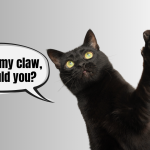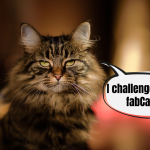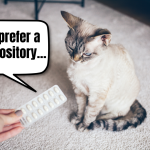Note: terms and laws referred to in this article for the ingredients listed on the packaging are accurate for polish pet food market, but may differ in your country, depending on local law regulations.
Every responsible cat Carer wants to feed their cats as best as possible, making sure their meals are not only tasty, but also nutritious. Recent years brought more awareness to what’s necessary in cat’s diet and what’s not really appropriate: we substitute low quality grocery store cat food with much better, higher-end products and throw out dry food to provide our kitties with species-appropriate food. What can you do, however, if you’re just starting to get into the topic? How to read labels and not make mistakes while buying cat food? Since we’re going through the process of getting our own cats on better quality food right now, we prepared for you, our dear fabCats, a beginners guide: How to evaluate and buy cat food?
What should go into a can of cat food?
Cats are obligate carnivores and their diet should consist of meat only, as their bodies are not made to digest vegetables and plants. As animal nutrition specialist Agnieszka Cholewiak-Góralczyk says in her book, proper nutrition should correspond to the organism’s natural needs and cater to its biological needs. It should always be appropriate for the species of the animal, their age, health, physiological state and their level of physical activity. How does it apply to cats? To provide them with the most nutritional value necessary to keep them healthy and active, we should be feeding them meat, either with commercial wet cat food, raw food (BARF, which is raw meat with proper supplements) or Whole Prey (feeding with small, frozen thawed animals that would be natural prey for cats in nature – mostly birds or rodents bred as feeder food, available to buy frozen e.g. in reptile stores. It may seem like a drastic way of feeding, but it’s actually the most natural for cats – their prey is actually dying being tortured by the cat, but once it’s thawed, the cat can play before eating, completing the hunt-catch-kill cycle).
Okay, you might say, but what about the fact that all cat food has meat as an ingredient? It’s even on the first place of the list in dry food. Unfortunately, fabCat, not everything that you see on a store shelf is made with species-appropriate nutritional requirements in mind. Cats never got the ability to acquire nutritional value from plants or the ability to digest carbs and starch, so it isn’t that good for their diet (with some exceptions). Meanwhile, in most commercial cat food and dry food in particular, it’s the starches and carbs that dominate the ingredients list. Meat, even if it’s in the first place on the ingredients list, turns out to be such a small percentage it can’t be really classified as quality cat food.
Reading the ingredients: what do some typically-used terms on cat food cans mean?
Let’s get down to the nitty-gritty. Taking any can of cat food into your hand in the pet store, you’ll never see “100% chicken meat” and nothing more. It’s simply impossible. In most high-quality commercial wet food you will find a very high percentage of muscle meat specifically (with smaller percentages of liver and giblets) and proper supplementation. They’re called “complete cat food” and can make a complete cat diet thanks to the appropriately balanced nutritional value.
Reaching for more commercial, grocery-store available cat food, we’re often met with terms such as: “meat and animal by-product (4% chicken), 30% chicken, chicken flavour, with chicken, rich in chicken, chicken and veal dish… Whatever the name, none of the terms above give us any concrete information and, what’s worse, none of them indicate good quality cat food. According to the FEDIAF Code of Good Labelling Practice for Pet Food, “chicken flavour” means that there’s only up to 4% chicken product, “with chicken” means it’s between 4-14%, “rich in chicken” is between 14-26% and “chicken dish” has at least 26% of chicken. We’re intentionally not saying chicken meat, as it doesn’t necessarily have to be all meat – the terms used can also apply to animal by-products like heads, skins, blood, beaks, feathers and more. Doesn’t sound appetizing, does it? Finish it off with rice, potatoes or other fillers and carbs… cat food shouldn’t be like that!
Ps. Using terms like “30% chicken”, “60% chicken” doesn’t say much, because without having the actual percentage of meat and giblets we’re not sure if 60% chicken means all meat and hearts, or is it just liver, guts and other innards.
Vitamins and minerals in cat food
Beside the ingredients list, cat food packaging should supply you with information on analytical constituents, listing protein, fat, fibre, ash and moisture percentages. Producers also declare nutritional additives per kg, according to FEDIAF guidelines, as in example:
Vitamin D3 (200 IU), taurine (1500mg), zinc [as zinc oxide] (25mg), manganese [as manganese-(II)-oxide] (1.4mg), iodine [as calcium iodate anhydrous] (0.75mg).
Some supplements, used both in commercial cat food and with BARF, include: barm (inactive) as vitamin B supplement, algae, fish oil, hemoglobin, taurine and calcium supplements.
What should you look out for while choosing cat food?
Quality cat food doesn’t have grain, sugars or plant-based thickeners. It should always have the percentage of meant and innards clearly stated, with well-balanced protein, fibre, fat and ash. Always try and read the labels, check the ingredients list and choose consciously, as good quality feeding doesn’t necessarily have to be expensive. Beside the examples we already gave you, some “smart” methods of convincing the consumer to buy lower quality pet food might include:
unnecessary longer ingredients list with products split into different groups (e.g. fat, poultry protein, dried liver) which makes it seem like there’s a lot of meat when, in fact, the food is still mostly plant thickeners (starch, beetroot pulp, rice, corn).
terms like “fresh meat” which are meaningless especially in dry food. In reality, once the meat is dried, the water evaporates and your “100g fresh meat in a portion” turns out to be 20-30g meat and 70% plant thickeners.
“protein” highlighted many times in the ingredients list. It subconsciously tells you it’s meat protein, but in fact, if you don’t read carefully, most of it can be plant protein unnecessary in a cat’s diet.
While shopping for cat food, try avoiding terms like “flavoured” or “rich in” – most high quality cat food producers will say directly the type of meat the food was made with, without extra decorative langage. Although terms like those don’t automatically classify wet food as bad quality, when you see them make sure to read the ingredients list carefully.
Time for some real-life examples
Let’s practice some more, reading labels that you can actually find in most pet shops. Wet food mentioned below is sorted from the worst to the best, as far as ingredients go:
poor quality cat food: 4% chicken, 4% meat, fish and fish product, grains, vegetables (min. 4% peas and carrot), egg, protein extract, minerals, sugar.
With food like this we know practically nothing about the ingredients, except for the fact that it’s full of thickeners, grains and sugar which should have no place in your cat’s diet.
Medium quality cat food: 25% beef (lungs, liver, hearts), broth, duck 15% (gizzards, meat 5%, liver, skins), chicken 15% (liver, hearts, gizzards), pork 10% (gizzards), minerals.
At first glance, it all looks well, but once you get a closer look, there’s only 5% meat and the rest is just innards: liver and gizzards. It’s not the worst and you can safely use it while getting your cat onto a better diet, but for long term use it’s better to choose pet food with more meat percentage.
High quality cat food: chicken (94%, including: 75% breast, 1% liver, 5% neck, 5% hearts, 5% body), beetroot (2%), egg (2%), minerals (1,5%), linseed oil (0,5%).
Despite there being some carbohydrates, the producer chose to use mostly meat (75% meat and just 25% livers, neck and hearts), and the overall meat contents is 94%.
Conclusion
Beside the quality of the pet food you give to your kitties, taking care of their dietary needs should also mean a constant access to fresh water (even if good quality wet food fulfills cats’ required water intake, water should always be accessible), giving small meals frequently (rather than large meals two times a day or providing unlimited access to dry/wet food) and taking them for regular vet checkups. We believe, dear fabCats, that your pet bowls are filled only with the best quality cat food. However, if you’re just now on your way to better nutrition or getting into the topic of cat diet, we hope our article directs you to the right path.
P.S. The information gathered in our article was based on general recommendations provided by cat dietitians and nutrition specialists. The content we created here is just an introduction to proper cat nutrition. We’re aware that we’re not experts, which is why we can only show you, dear fabCats, a good direction and a starting point to go from. If you need some deeper explanation for some of the issues concerning proper cat nutrition, someone to adjust your kitty’s diet to their individual health problems or help in getting them onto better quality food, we recommend consulting with a specialist. Dietitians specialising in cat nutrition can help you create a feeding plan fit for your cat, based on most recent health tests and observations.
P.S. 2 Today is the last day of our facebook fabCat COMPETITION! If you haven’t had a chance to take a look yet, now it’s your last chance for some great prizes 🏆 and a lot of fun with some kitty projects. Get any cardboard boxes you can (our myKotty product packaging will be purrfect) 📦 – more details in the link. Ready for a challenge? 🥊




